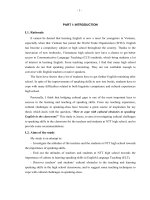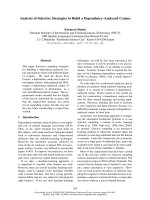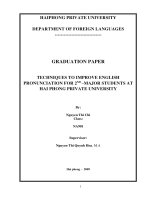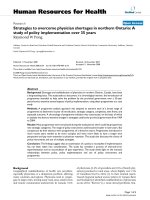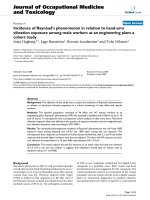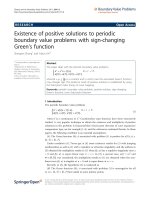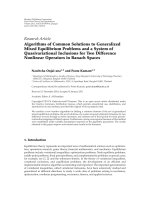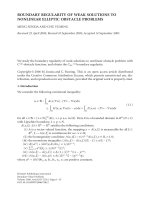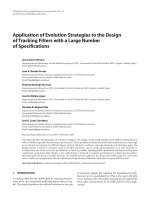utilizing metacognitive awareness of reading strategies to overcome reading comprehension problems among efl learners at nguyen tat thanh university
Bạn đang xem bản rút gọn của tài liệu. Xem và tải ngay bản đầy đủ của tài liệu tại đây (1.17 MB, 147 trang )
MINISTRY OF EDUCATION AND TRAINING
HO CHI MINH CITY OPEN UNIVERSITY
PHAN NGOC HUY
UTILIZING METACOGNITIVE AWARENESS OF
READING STRATEGIES TO OVERCOME READING
COMPREHENSION PROBLEMS AMONG EFL
LEARNERS AT NGUYEN TAT THANH UNIVERSITY
MASTER OF ART IN TESOL
Ho Chi Minh City, June 2019
STATEMENT OF AUTHORSHIP
I certify that this thesis entitled “Utilizing Metacognitive Awareness of Reading
Strategies to Overcome Reading Comprehension Problems among EFL Learners at
Nguyen Tat Thanh University” is my own work.
Except where reference is made in the text of the thesis, this thesis contains material
published elsewhere or extracted in whole or in part from a thesis by which I have
qualified for or been awarded another degree or diploma.
No other person’s work has been used without due acknowledgement in the main text
of the thesis.
This thesis has not been submitted for the award of any degree or diploma in any other
tertiary institution.
Ho Chi Minh City, June 2019
PHAN NGOC HUY
i
ACKNOWLEDGEMENTS
This Master of Arts in TESOL thesis is the result of a fruitful collaboration of all the people
who have kindly contributed with an enormous commitment and enthusiasm in my
research. Without the help of those who supported me at all times and in all possible ways,
it would not have been feasible for me to complete my M.A. thesis.
First of all, I am deeply indebted to my supervisor, Dr. NGUYEN DINH THU, from Ho
Chi Minh City University of Technology and Education, whose compassion,
encouragement and guidance throughout the research have helped in the completion of this
thesis. I have truly learned from the excellence of his skills and from his wide experience
in research; no words are adequate to describe the extent of my gratitude.
I am also sincerely grateful to all lecturers of the Open University in Ho Chi Minh City for
providing me with invaluable sources of intellectual knowledge during my study there.
This knowledge was very useful when I conducted this research.
Besides, a big thank you goes to my family for their financial and spirit support during my
thesis completion process.
I owe a great debt of gratitude to the anonymous participants who contributed data to this
thesis. Without them the data collection for this study could not properly been carried out.
ii
ABSTRACT
Reading is a complex information processing skill in which the readers interact with the
text in order to create meaning discourse; therefore, most Vietnamese EFL students can
hardly avoid reading comprehension problems. In addition, metacognitive strategies have
been proved as a potential way to heighten EFL readers’ meaning construction, reading
comprehension and help them to avoid reading problems. Hence, the prominent purpose of
the present research was to discover the university learners’ reading problems, along with
their perceptions and actual utilization of metacognitive reading strategies during their
reading process.
To achieve this purpose, a body of literature on reading comprehension, reading problems
and metacognitive strategies were reviewed in the theory chapter to shape the theoretical
framework of the study.
Based on this conceptual framework, the study was conducted at the Nguyen Tat Thanh
University with the sample of 78 EFL fourth-years. Data were collected through three
instruments of a 48-item questionnaire, a reading comprehension test and an interview.
Quantitative results from the questionnaire and the test were analyzed by SPSS 20.0 while
qualitative results from the interview were thematically analyzed.
The findings of the study indicated that most of the target sample often encountered reading
problems apropos of linguistic knowledge, background knowledge, motivation and reading
strategy use. In addition, although most of them agreed on the great merits of metacognitive
reading strategies, which would help them self-plan, self-monitor and self-evaluate their
reading process, their actual use frequency of these strategies was at a low level. Moreover,
problem-solving strategies were remarkably utilized among the EFL learners rather than
other groups including global strategies and supporting strategies.
Based on the research findings, the paper concluded with some pedagogical implications
and a recommendation for further study in the line of research on metacognitive reading
strategies to tackle reading breakdowns and improve reading comprehension.
iii
TABLE OF CONTENT
Page
STATEMENT OF AUTHORSHIP
i
ACKNOWLEDGEMENTS
ii
ABSTRACT
iii
TABLE OF CONTENT
iv
viii
LIST OF TABLES
LIST OF CHARTS, FIGURES
x
Chapter 1: INTRODUCTION
1
1.1. Educational and Social-cultural Background of the Study
1
1.2. Rationale for the Study
2
1.3. Problem Statement
4
1.4. Research Objectives
6
1.5. Research Questions
6
1.6. Structure of the Thesis
7
9
Chapter 2: LITERATURE REVIEW
2.1. Background of Reading Comprehension
9
2.1.1. Definitions of Reading Comprehension
9
2.1.2. Reading Comprehension Models
9
2.1.2.1. Bottom-up Model
10
2.1.2.2. Top-down Model
11
2.1.2.3. Interactive Model
12
2.1.3. Reading Comprehension Problems
13
2.1.3.1. Language Knowledge-related Problems
13
2.1.3.2. Background Knowledge-related Problems
14
2.1.3.3. Reading Strategy-related Problems
15
2.1.3.4. Reading Motivation-related Problems
15
2.2. Background of Metacognitive Reading Strategies
2.2.1. Reading Strategies
16
16
2.2.1.1. Definitions of Reading Strategies
16
2.2.1.2. Classifications of Reading Strategies
18
iv
2.2.2. Metacognitive Reading Strategies
18
2.2.2.1. Metacognitive Awareness or Metacognition
18
2.2.2.2. Definition of Metacognitive Reading Strategies
19
2.2.2.3. Types of Metacognitive Reading Strategies
20
2.2.3. Knowledge Source Necessitating Metacognitive Awareness in Strategic
23
Reading
2.2.3.1. Declarative Knowledge
23
2.2.3.2. Procedural Knowledge
24
2.2.3.3. Conditional Knowledge
24
2.2.4. Metacognition in EFL Reading Strategies among Skilled and Unskilled Readers
25
26
2.3. Previous Studies
2.3.1. Outside Vietnamese Context
26
2.3.2. Inside Vietnamese Context
27
2.3.3. Research Gaps
28
2.4. Chapter Summary
33
Chapter 3: METHODOLOGY
34
3.1. Overall Approach
34
3.1.1. Case Study
34
3.1.2. Mixed Methods Design
35
3.1.3. Research Sampling Technique
36
3.1.3.1. Phase 1: The Sample of Questionnaire Piloting
36
3.1.3.2. Phase 2: The Sample of Questionnaire and Test Main Study
37
3.1.3.3. Phase 3: The Sample of Interview Involvement
37
37
3.2. Research Context and Participants
3.2.1. Research Context
37
3.2.2. Overview of the EFL Curriculum of the Current Research Context
38
3.2.3. Research Participants
40
3.3. Data Collection Instruments
41
3.3.1. Questionnaire
42
3.3.1.1. Rationale for Questionnaire
42
3.3.1.2. Description of the Questionnaire (See Appendices A.1, A.2)
43
3.3.1.3. Piloting the Questionnaire
45
v
3.3.1.4. Collecting Data from the Questionnaire
3.3.2. Reading Comprehension Test
46
46
3.3.2.1. Rationale for Test
46
3.3.2.2. Selecting and Piloting the Test
47
3.3.2.3. Description of the Utilized Test (See Appendix B)
48
3.3.2.4. Collecting Data from the Test
48
3.3.3. Interview
49
3.3.3.1. Rationale for Interview
49
3.3.3.2. Justifying the Interview
49
3.3.3.3. Description of the Final Version of Interview (See Appendices C.1 and
50
C.2)
3.3.3.4. Collecting Data from the Interview
51
52
3.4. Analytical Framework
3.4.1. Descriptive Analysis of the Questionnaire
52
3.4.2. Statistical Analysis of the Test
53
3.4.3. Thematic Analysis of the Interview
53
54
3.5. Methodological Issues
3.5.1. Reliability and Validity
54
3.5.1.1. For the Questionnaire
54
3.5.1.2. For the Reading Comprehension Test
55
3.5.1.3. For the Interview
55
3.5.2. Ethical Considerations
55
3.5.2.1. Consent Form
55
3.5.3.2. Anonymity and Confidentiality
56
3.5.3. Triangulation of the Study
56
56
3.6. Chapter Summary
Chapter 4: DATA ANALYSIS AND DISCUSSION
57
57
4.1. Data Analysis
4.1.1. Data Analysis of the Questionnaire
57
4.1.1.1. Reliability Value (Cronbach’s Alpha)
57
4.1.1.2. Theme 1: Students’ Reading Problems
58
vi
4.1.1.3. Theme 2: Students’ Perceptions on the Benefits and Challenges of
61
Utilizing Metacognitive Reading Strategies
4.1.1.4. Theme 3: Students’ Actual Practice on Using Metacognitive Reading
63
Strategies
4.1.2. Data Analysis of the Test
71
4.1.3. Data Analysis of the Interview
73
4.1.3.1. The Interviewees’ Reading Comprehension Problems
73
4.1.3.2. The Interviewees’ Perception on Using Metacognitive Reading
80
Strategies
4.1.3.3. The Interviewees’ Actual Utilization of Metacognitive Reading Strategies
84
88
4.2. Discussion
4.2.1. Research Question 1
88
4.2.2. Research Question 2
91
4.2.3. Research Question 3
93
95
4.3. Chapter Summary
Chapter 5: CONCLUSION AND IMPLICATIONS
96
5.1. Conclusion
96
5.2. Implications
98
5.2.1. For the Learners
98
5.2.2. For the Teachers
99
5.3. Limitations
100
5.4. Recommendations for Further Study
100
5.5. Chapter Summary
101
REFERENCES
102
APPENDIX A.1: QUESTIONNAIRE (ENGLISH VERSION)
110
APPENDIX A.2: QUESTIONNAIRE (VIETNAMESE VERSION)
114
APPENDIX A.3: SURVEY OF READING STRATEGY (ORIGINAL VERSION)
118
APPENDIX B: READING COMPREHENSION TEST SAMPLE
119
APPENDIX C.1: INTERVIEW PROMPTS (ENGLISH VERSION)
128
APPENDIX C.2: INTERVIEW PROMPTS (VIETNAMESE VERSION)
129
APPENDIX D.1: CONSENT FORM FOR DEAN
130
APPENDIX D.2: CONSENT FORM FOR STUDENT PARTICIPANTS
131
vii
APPENDIX E.1: TRANSCRIPT SAMPLE (ENGLISH VERSION)
132
APPENDIX E.2: TRANSCRIPT SAMPLE (VIETNAMESE VERSION)
134
LIST OF TABLES
Page
Table 2.1
A Recap of Reading Strategy Definitions
16
Table 2.2a
A Periodic Classification of Metacognitive Strategy Groups
21
Table 2.2b
A Functional Classification of Metacognitive Strategy Groups
22
Table 2.2c
A Nature-driven Classification of Metacognitive Strategy Groups
23
Table 2.3
A Recap of Previous Studies
29
Table 3.1a
General Learning Outcomes of the EFL Curriculum
39
Table
Specific Learning Outcomes of the EFL Curriculum
39
Table 3.2
Demographic Information of the Participants (N=78)
41
Table 3.3
The Links between Research Questions and Research Instruments
42
Table 3.4
Description of the Questionnaire Content
44
Table 3.5
Reliability of the Piloted Questionnaire
45
Table 3.6
Description of the Test Structure
48
Table 3.7
Description of the Interview Content
50
Table 3.8
Description of the Interview Sessions
51
Table 3.9
IELTS Reading Marking Scheme (Academic)
53
Table 4.1
Reliability of the Student Questionnaire for Total Items (Items 1-48)
58
Table 4.2
The Participants’ Reading Comprehension Problems
58
Table 4.3
Students’ Perceptions on the Benefits and Challenges of Utilizing
61
3.1b
Metacognitive Reading Strategies
Table 4.4
Students’ Use of Global Group of Reading Strategies
64
Table 4.5
Students’ Use of Problem-solving Group of Reading Strategies
66
Table 4.6
Students’ Use of Support Group of Reading Strategies
68
Table 4.7
Students’ Overall Use of Reading Strategies
70
Table 4.8
The Mean Value of the Test Scores
71
viii
Table 4.9a
The Interviewees’ Linguistic-related Problems
74
Table
4.9b
Table 4.9c
The Interviewees’ Background Knowledge-related Problems
76
The Interviewees’ Motivation-related Problems
77
Table
4.9d
Table 4.10
The Interviewees’ Reading Strategy-related Problems
78
The Interviewees’ Perceptions on Utilizing Metacognitive Reading Strategies
81
Table 4.11
The Interviewees’ Actual Utilization of Metacognitive Reading Strategies
85
ix
LIST OF CHARTS, FIGURES
Page
Figure
The Research Procedure
36
The Reading Test Score Distribution
72
3.1
Chart 4.1
x
Chapter 1
INTRODUCTION
1.1. Educational and Social-cultural Background of the Study
Since the 1986 Open Door policy that stimulated foreign investment, socioeconomic refinements have enhanced the teaching and learning of English throughout the
whole country. Therefrom, English has been approved as a compulsory subject in the
authorized curricula from secondary schools to universities, and recently from the three
primary grades 3, 4 and 5. Aside from being a mandatory subject at educational sites,
Vietnamese students learn English for a specific purpose such as tourism, banking, or
business. In general, English has become the most influent foreign language in the context
of the open door policy (Hoang, 2013).
One of the most important decisions in the teaching and learning of English was
Decision No. 1400/QĐ-TTg on the national educational three-stage plan for “Teaching and
Learning Foreign Languages in the National Educational System, Period 2008-2020” dated
September 30, 2008 (Duong, 2015). The first stage (2008-2010) aspires to developing a
ten-year foreign language curriculum, composing a foreign language textbook series, and
drawing up for piloting the curriculum from the third grade to higher education; while the
second stage (2011-2015) emphasizes the application of the ten-year foreign language
curriculum into the educational system throughout the country; and the objective of the
third stage (2016-2020) is to make modifications to the ten-year foreign language
curriculum and to develop profound programs for vocational schools, colleges, and
universities. Thus, the ultimate goal of the National Foreign Language Project is for
Vietnamese students to become proficient in the English language by 2020.
In respect of English programs at the Vietnamese tertiary level, Decision No.
36/2004/QĐ-BGD-ĐT promulgates that the inclusive aim is to offer students with
background knowledge, professional skills, and professional behaviors so that they can
work efficiently in specialized areas in which English is means of communication (Duong,
1
2015). Therefore, the bachelor’s degree of English-major program in a Vietnamese
university must strictly abide by the framework specified by the Vietnamese Ministry of
Education and Training. The Vietnamese students at this schooling system take all predetermined courses in the general knowledge phase before moving to their specialized
phase such as Interpretation and Translation, TESOL, Business, or Literature, etc.
1.2. Rationale for the Study
Since printed language has been remarkably developed in recent decades, reading
seems to become more and more indispensable in modern life (Kasim & Raisha, 2017).
People spend more time on reading activities for various purposes in different ways. For
example, people read newspapers, magazines, advertisements and so on to get the
information necessary for their daily work and life. In professional environments, people
are also asked to engage in intensive reading activities related to their daily work. Similarly,
in the academic environment like English as a Foreign Language (EFL) / English as a
Second Language (ESL) community, reading is one of the most popular and regularly
mandatory activities that language students must do constantly to satisfy their academic
demands. Literally, specific to language learning contexts, reading is a fundamental skill
that can improve students’ vocabulary and structures, speaking and writing (Do & Nguyen,
2014).
However, reading comprehension is still one of the most controversial topics in EFL
reading classrooms these days since it has been extensively set in various ways by
numerous theorists. It is viewed as a complicated process in which a set of skills and subskills are employed (Cain, Oakhill & Bryant, 2004), to understand what is read, which is
the terminal goal of any kind of reading (Carnine, Silbert, Kame’enui, & Tarver, 2009). In
this sense, the desire of any EFL readers is to comprehend the texts intensively.
Particularly, during university education, the necessity of reading and understanding the
text including a multiple of concepts in different fields of study increases the necessity of
comprehension (Solmaz, 2015). In fact, however, many EFL readers are still struggling to
2
gain mastery over their reading comprehension problems (Kasim & Raisha, 2017). A
variety of possible problems in the EFL reading classroom can be specified such as limited
vocabulary range, lexical and syntactic knowledge, inefficient reading skills, etc. (Grabe,
1991; Cabaroglu & Yurdaisik, 2008; Kasim & Raisha, 2017). As a matter of fact, reading
is of complexity due to various obstacles (e.g. background knowledge, language
proficiency, and metacognitive capacity) causing huge influence on the readers’ reading
processes and their comprehension of written texts (Karbalaei, 2010; Ismail & Tawalbeh,
2015; Meniado, 2016). Reading comprehension, for those reasons, is uneasy for many EFL
learners to achieve.
In another way, Yukselir (2014) explicates that reading comprehension is the
product of serpentine linkages among text, setting, the reader’s background knowledge and
reading strategies. Emerged from this author’s definition, reading strategies are of the
factors directly contributing to reading comprehension degree. Unquestionably, different
learners may tackle reading tasks in different ways and some of them seem to achieve better
comprehension (Do & Nguyen, 2014). In theory and practice, pursuing recent researches
in the field of reading strategies is to investigate the most effective techniques or
approaches the EFL readers’ opt for handling the written texts. Many studies have broadly
centralized on EFL readers’ awareness of reading strategies, and strategy training enabling
them more effective reading comprehension. In fact, contemporary researches have
evidently documented that good readers possess the comprehensive metacognitive
awareness of reading strategies, and utilize these tools effectively and reasonably so as to
finish the specific given reading tasks (Ismail & Tawalbeh, 2015). Unfortunately, many
EFL learners, particularly in Vietnamese context, almost suffer from reading
comprehension problems. That being the case, it is crucial for the current researcher to
make an investigation into the use frequency rate of metacognitive reading strategies
among the EFL students at Nguyen Tat Thanh University together with their perceptions
on benefits and challenges of utilizing metacognitive strategies in fortifying their reading
comprehension.
3
1.3. Problem Statement
Researches in the Vietnamese context on reading comprehension have broadly
reported that EFL learners usually face some difficulties when they read written texts. To
begin with, the practice of strategic reading instruction and reading comprehension
assessment has profoundly governed by the traditional approach (i.e. Grammar-Translation
Method) in which teachers and tasks in the instructional materials are vital centers while
students turn out passive in their reading process, and both teachers and students are strictly
bound by the prescribed curricular (Le, 2010). For example, a typical EFL reading activity
in the Vietnamese context is to instruct students know how to answer the given
comprehension questions from the reading passages. Hence, teaching students reading
strategies to complete these reading tasks seems to be disregarded in such classes (Nguyen
& Trinh, 2011). In respect of the assessment approach, Le (2010) describes that the
teachers’ assessment on Vietnamese students’ EFL reading comprehension is strictly on
the multiple-choice patterns and put emphasis on test-taking skills rather than reading
performance. As a consequence, students automatically think that EFL reading learning is
subject to complete the reading tasks and tests successfully. As a matter of fact, it usually
takes the EFL readers much more time to accomplish the assigned reading tasks due to lack
of directive actions and strategic intention; consequently, their reading performance is
virtually unsatisfactory. Clearly, reading comprehension is one of the most salient agents
determining whether the readers are successful or not. However, reading comprehension
“is the most challenging and difficult task for the learners in studying English” (Bui, 2017,
p. 89).
Particularly, one of the most important factors is the students’ use of reading
strategies. Many Vietnamese students regardless of educational systems and/or levels,
during their EFL reading activities, do not utilize reading strategies efficiently if any
(Nguyen, 2018). There is no doubt that awareness and use of reading strategies has direct
and consistent correlation with reading comprehension ability performed by the EFL
readers.
4
Aside from use of reading strategies, strategic reading instruction and assessment
mentioned above, Nguyen (2005) explains the four agent sources impacting the
Vietnamese students in their EFL reading practice, including [1] teaching context, [2]
teachers’ professional experience, [3] students’ level of motivation, and [4] materials and
curriculum. At the start, on the grounds that the time allocation for each reading class is
extremely sparse, teachers are only able to help their students understand the reading texts
and do all required tasks but teach all necessary responsive strategies to them. Considering
teachers’ professional experience, the findings of Nguyen’s (2005) study show that the
younger teachers are fully aware of the urgency of explicit reading strategy instruction to
the students but the older teachers do not teach their students these strategies. Regarding
student-related factor, Nguyen (2005) says that Vietnamese students are so lowly
motivated and little interested in reading learning at classes where their teachers are not
passionate enough to help them become more strategic readers. Supplementary to three
aforementioned factors, Nguyen (2005) reckons that “the materials [textbooks] do not
provide appropriate strategies to apply for specific activities” (p. 43). This matter
considerably challenges the teachers in deploying reading strategy instruction in their
classrooms.
To encapsulate this part, a greater part of Vietnamese students from high schools to
tertiary institutions including Nguyen Tat Thanh University may unavoidably experience
reading comprehension problems. Most remarkably, cognizance and employment of
reading strategies among the students are actually immature and inefficient. By this reason,
the current issue of EFL reading comprehension in the Vietnamese context is still
problematic, negatively impacting on the EFL students’ overall language proficiency. That
being the case, the ultimate goal of the National Educational Project in formulating
Vietnamese students to become proficient in the English language by 2020 is perhaps
strenuously accomplished. In brief, the essential task here is that EFL students have to
improve their reading performance in order to survive in their academic environment and
manage lifelong learning skills.
5
1.4. Research Objectives
As mentioned earlier, reading is a complicated processing skill the readers
manipulate to form meaning discourse (Silberstein, 1994); therefore, most Vietnamese
EFL students can hardly avoid reading comprehension problems. By this premise, one part
of this research is dedicated to clarifying what reading comprehension problems the
students faced in their EFL reading classroom at Nguyen Tat Thanh University in specific.
On the other hand, in theory, metacognitive strategies heighten EFL readers’
meaning construction, reading comprehension and help them to avoid reading problems
(Israel, 2007). Hence, a large part of the present research is to discover the actual utilization
of metacognitive reading strategies in terms of frequency rate and types. Particular to the
findings of this part, the research can analyze the potential reading problems if any, as well
as propose some practical recommendations for the EFL learners at Nguyen Tat Thanh
University to get rid of their existing reading problems.
Besides, as an additional part of this research, an insight into the EFL readers’
awareness of benefits and challenges of utilizing metacognitive strategies in their reading
processing skill is practically advantageous for the language teachers in determining or/and
reshaping their pedagogical thoughts and behaviors of EFL reading instruction and reading
strategy training as well.
1.5. Research Questions
The research questions posed for the current study are as follows:
RQ.1: What obstacles hamper the EFL learners’ reading comprehension capacity at
Nguyen Tat Thanh University?
RQ.2: How do the EFL learners at Nguyen Tat Thanh University perceive the
benefits and challenges of utilizing metacognitive strategies during their
reading process?
6
RQ.3: What is the actuality of utilizing metacognitive awareness of reading
strategies among the EFL learners at Nguyen Tat Thanh University in terms
of frequency and types?
1.6. Structure of the Thesis
In Chapter 1, the researcher has just presented the Vietnamese educational and
socio-cultural background of the study, the rationale for the study, the problem of the study,
the research objectives and research questions.
Chapter 2 describes the theoretical background for the study. This chapter is made
up by three main parts. The first part covers the overall concept of reading skill including
definition, necessity, reading comprehension models and reading processes as well. The
next part presents metacognition or metacognitive awareness in using of EFL reading
strategies adhered to the comparison between skilled and unskilled readers, and a
conceptual framework for this study. Finally, this chapter reviews some previous studies
in conjunction with awareness and use of the metacognitive reading strategies in EFL
reading classrooms, which helps the research to shape its methodology.
Chapter 3, Methodology, contains an informative description of the context and
population, data collection methods abided by how they are designed and shaped.
Afterward, this chapter also paves the way for depicting how the data are collected and
analyzed. Besides, the reliability and validity, ethical issues area are also extensively
included.
Chapter 4 yields an overall display of data sources and discussion of the results of
the study gathered from the analyses of these data.
Finally, Chapter 5 displays a summary of the findings and a discussion within the
specific context of Nguyen Tat Thanh University and the particular population of EFL
learners of the Faculty of Foreign Languages. Furthermore, an attempt is made to justify
the design of the study in terms of strengths and limitations, followed by some
7
recommendations are suggested for EFL students, teachers, future researchers and
practitioners in the field of metacognitive reading strategy training.
Chapter 2
LITERATURE REVIEW
2.1. Background of Reading Comprehension
2.1.1. Definitions of Reading Comprehension
8
Reading, basically, is a lifelong skill to be utilized both at school and throughout
daily life. Obviously, without an ability to read effectively, chances for personal attainment
and career success can hardly be achieved. In spite of its acknowledged essence, reading is
deemed to be one of the most formidable fields in the foreign language education arena.
Indeed, Anastasiou and Griva (2009) claim that reading is a complicated process
necessitating an integration of psycholinguistic, perceptual and cognitive abilities.
Supportively, Gough and Juel (1991) depict that reading comprises decoding and
comprehension, in which two these components would take place synchronously.
Decoding is to work out the words of the text while comprehension is to understand what
to be read (Do & Nguyen, 2014).
Theoretically, reading comprehension is an interactive course of decoding both the
surface and hidden meanings of a text (Rumelhart, 1994, cited in Meniado, 2016),
summoning a multiplicity of skills and facets such as “the perception of words, clear grasp
of meaning, thoughtful reaction, and integration” (Hermosa, 2002, p. 63). Furthermore,
reading comprehension is a complex cognitive capacity requiring the readers to combine
text data with their background knowledge (Meneghetti, Carretti, & Beni, 2006). To recap,
reading comprehension refers to the ability to understand a text in need of a sensible
linguistic knowledge, an ability to find out key ideas, an identification of discourse
structure, and strategic procedure (Grabe, 2009).
2.1.2. Reading Comprehension Models
In the realm of reading a foreign language, there are three conventional models,
which facilitate reading comprehension and help readers tackle their reading problems
while reading (Eskey, 2005), namely bottom-up model, top-down model, and interactive
model (Grabe, 2009). In principle, this research paper aims to address both merits and
shortcomings of each of these models.
2.1.2.1. Bottom-up Model
9
A bottom-up reading model is a model focusing on step-by-step mechanical
processing of a text, moving from the perception of single phonemes to words, clauses,
sentences and then the whole section of discourse (Grabe, 2009). In this model, according
to Ahmadi et al. (2013), the whole reading process is based on the linguistic features (e.g.
words, phrases, sentences) and readers interpret meaning from the printed texts by
recognizing or decoding each individual word. To be more specific, decoding of the written
text involves a visual emphasis on “the identification of the letters, noticing the
combination of the letters, recognition of the words, establishing sentences via their
syntactic structures […] until the meaning of the text is eventually determined” (Shahnazari
& Dabaghi, 2014, p. 8). As stated by Pressley (2000), this model believes that proficient
decoders are the readers who are able to understand words and syntactic structures quickly,
leading to their good reading comprehension. However, the readers of this model can
encounter some unavoidable obstacles as follows:
First, this model of reading process may waste much time and effort in reading
comprehension as short-term memory capacity is restricted, and readers forget rapidly what
they have just read when reading finishes (Van, 1999);
Second, this model fails to value the benefaction of the readers’ background
knowledge to their reading comprehension. Otherwise, the reader’s world knowledge,
contextual information, and other strategies take an external role in arriving at information
in such a model (Alderson, 2000);
Third, with this model, the readers do not underestimate any part of the text during
reading act; that is, they do not process it strategically and consciously (Shahnazari &
Dabaghi, 2014).
In short, recognition of the shortcomings arising from the bottom-up model in
developing reading comprehension paves the way for the emergence of the top-down
reading model (Eskey, 2005). The top-down model is precisely discussed below with its
description, advantages and limitations.
10
2.1.2.2. Top-down Model
Davoudi and Moghadam (2015) describe the model as a reading process in which
readers receive the information from the print texts by contrasting it with their world
comprehension so as to conceive what is read, “bring[ing] meaning to the text based on
their experiential and interpretive prior knowledge” (p. 173). This knowledge source helps
the readers visualize the content of the texts. Some good points of this reading
comprehension model are enumerated as follows:
First, the readers’ background knowledge and other interpretive skills adhered to
the cognitive and metacognitive strategies facilitate reading comprehension (Davoudi,
2005). To wit, the comprehension process is neither mechanical nor linear, but strategically
conducted by the readers (Grabe, 2009);
Second, underlying this model, readers are only recognizant of language items to
confirm their presumption on the meaning of the texts. It means that they easily capture the
text by contextual and linguistic clues (Grabe, 2009).
To summarize, the meaning of a reading text is decoded by the readers’ activation
of prior background knowledge and discourse elements (Koda, 2005). Nevertheless, the
biggest challenge of this reading model is that the readers usually possess little background
knowledge on the topic and it is difficult to set up predictions, consequently. From the
predicaments exuded from the bottom-up and top-down models, “for the bottom-up model,
it fails to consider the reader’s function in the reading process, while the top-down model
relies too much on the reader’s background linguistic and conceptual knowledge and
ignores the importance of the text” (Ahmadi, et al., 2013, p. 239), numerous researchers
have commonly contended that the interactive model arises to yield a better outcome of
reading comprehension.
2.1.2.3. Interactive Model
Based on the conceptualization of Davoudi and Moghadam (2015), this model
details the readers’ driving the meaning of the written text and making interpretations
11
through simultaneous integration between the structure of the text and the readers’ existing
background input. To present, the interactive model literally signifies the combination of
the bottom-up and top-down models, shifting from lower-level processing skills (e.g. word
decoding) to higher-level critical thinking skills (e.g. text interpretation) to construct
reading comprehension (Grabe, 2009). The aim of this model lies that the readers can
simultaneously summon the information accessible to them from various knowledge
sources of either bottom-up or top-down models in the course of reading process (Ahmadi,
et al., 2013), that is, both linguistic schemata and world knowledge are pressed into service
(Grabe, 1991).
Regarding its disadvantages, an improper balance between the bottom-up and topdown models causes confusion in reading comprehension, hence formulating unsuccessful
readers. As an illustration of this, a student possessing exceptional word-recognition skills
but deficient reasoning skills may still suffer from reading comprehension problems.
Nevertheless, this model, as Rumelhart (1977, as noted in Davoudi & Moghadam, 2015)
confirms, is purified over the straight bottom-up and top-down models in its orientation.
2.1.3. Reading Comprehension Problems
In principle, reading is a process by which learners require a dozens of sources
including background knowledge, text schemata, and their personal purposes so as to make
sense
of
what
are
written
(Karbalaei,
2010).
Since
this
complexity,
a large number of EFL students are still striving to solve their reading comprehension
problems (Kasim & Raisha, 2017). Actually, reading comprehension problems have been
the heart of EFL reading environment for a long time. Gunning (2002) makes a research
endeavor to name possible problems obstructing EFL reading comprehension, namely,
scarcity of academic vocabulary range, sparse background knowledge, the deficiency of or
failure in use of reading strategies, lack of motivation and objective for reading. Similarly,
insufficient vocabulary, immature understanding of linguistic complexity, poor reading
skills and lack of background schemata are common examples of reading comprehension
problems among EFL readers (Grabe, 2009; Fitriani, 2014). In harmonization with these
12
authors, reading comprehension problems can be categorized into four groups, consisting
of [1] Language knowledge-related problems, [2] Background knowledge-related
problems, [3] Reading strategy-related problems, and [4] Reading motivation-related
problems. The details of these four groups are presented as follows:
2.1.3.1. Language Knowledge-related Problems
As stated by Anderson (2000), readers are always expected to acquire and master
language knowledge prior to their reading in second or foreign language. To enlighten,
language knowledge, also called linguistic knowledge, is knowledge about the linguistic
system of sounds, structures, meanings, words, and rules for putting them all
together (Fromkin, Rodman & Hyams, 2003, mentioned in Kasim & Raisha, 2017).
Alternatively speaking, the language knowledge problems are made up of semantic,
lexical, and syntactical reading problems. Alderson (2000) adds that the sparseness of
vocabulary and immaturity of language structures lead to decreasing the efficiency of
reading comprehension. Shortly, Lili (2014) claims that “good readers recognize and
decode words, grammatical structures and other linguistic features quickly and accurately”
(p. 136).
2.1.3.2. Background Knowledge-related Problems
According to Alfaki & Siddiek (2013), readers fail to make sense of a reading text
is caused by their lacking appropriate schemata that represent background or prior
knowledge. There are three prime patterns of schemata, including linguistics schemata,
formal schemata, and content schemata (Carrell, 1989):
Linguistics schemata are the reader’s current linguistics input about grammar,
vocabulary and language structures, of the most noteworthiness to text comprehension. The
13
more linguistics schemata readers engrave in their mind, the more fluently they decode and
comprehend the text information.
Formal schemata are background knowledge of the formal, rhetorical organizational
structure of various genres of texts (Carrell & Eisterhold, 1988). Readers can make use of
the genetic features of the reading texts (e.g., academic articles, stories, expositions, etc.)
to understand the written texts. In essence, the readers can activate the knowledge of text
genres to ease their reading comprehension because “the type of text will offer detailed
evidence of the content of the text” (Alhaisoni, 2017, p. 32).
Content schemata reflect the readers’ existing knowledge of a real and imaginary
world, cultural expertise and prior experience with a specific domain. Based on Alhaisoni
(2017), this type of background knowledge can compensate for the readers’ lack of
language schemata. Generally, the familiarity with the topics is of a huge influence on
readers’ reading comprehension. Especially, test takers, according to Alderson (2000), are
universally found to perform better reading comprehension whenever they are assigned to
subject fields in which they are experienced.
2.1.3.3. Reading Strategy-related Problems
Few would deny that reading strategies play an important function in the
comprehension of any text, and readers who are adequately furnished reading strategies
can comprehend the texts accurately and effortlessly (Paris & Jacobs, 1984, Do & Nguyen,
2014). However, there still exist many readers of a foreign language who are severely poor
of the distinct qualities of successful readers like word recognition skills, reading fluency,
and peculiarly, reading strategy awareness and utilization (Ismail & Tawalbeh, 2015). For
example, they are deficient of recognizing the main ideas of the texts; they get caught in
using
inferences
to
grasp
comprehensive
understanding
of
the reading texts; they are unable to control their reading progress (Lau, 2006). In brief,
there is no doubt that awareness and utilization of reading strategies has a direct and
consistent correlation with reading comprehension ability performed by the EFL readers.
Thus far, the readers need to provide themselves with effective and sufficient reading
14
